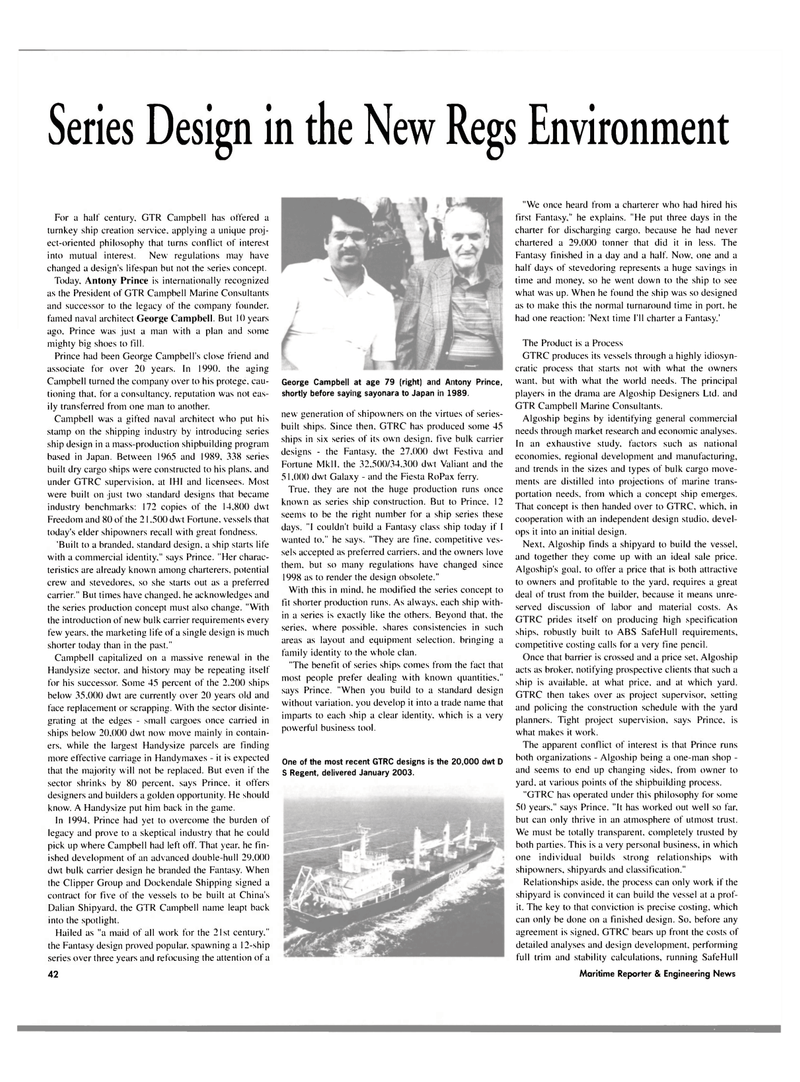
Page 47: of Maritime Reporter Magazine (February 2004)
The Tanker Yearbook: ATB Edition
Read this page in Pdf, Flash or Html5 edition of February 2004 Maritime Reporter Magazine
Series Design in the New Regs Environment
For a half century, GTR Campbell has offered a turnkey ship creation service, applying a unique proj- ect-oriented philosophy that turns conflict of interest into mutual interest. New regulations may have changed a design's lifespan but not the series concept.
Today, Antony Prince is internationally recognized as the President of GTR Campbell Marine Consultants and successor to the legacy of the company founder, famed naval architect George Campbell. But 10 years ago. Prince was just a man with a plan and some mighty big shoes to fill.
Prince had been George Campbell's close friend and associate for over 20 years. In 1990. the aging
Campbell turned the company over to his protege, cau- tioning that, for a consultancy, reputation was not eas- ily transferred from one man to another.
Campbell was a gifted naval architect who put his stamp on the shipping industry by introducing series ship design in a mass-production shipbuilding program based in Japan. Between 1965 and 1989. 338 series built dry cargo ships were constructed to his plans, and under GTRC supervision, at IHI and licensees. Most were built on just two standard designs that became industry benchmarks: 172 copies of the 14.800 dwt
Freedom and 80 of the 21.500 dwt Fortune, vessels that today's elder shipowners recall with great fondness. "Built to a branded, standard design, a ship starts life with a commercial identity," says Prince. "Her charac- teristics are already known among charterers, potential crew and stevedores, so she starts out as a preferred carrier." But times have changed, he acknowledges and the series production concept must also change. "With the introduction of new bulk carrier requirements every few years, the marketing life of a single design is much shorter today than in the past."
Campbell capitalized on a massive renewal in the
Handysize sector, and history may be repeating itself for his successor. Some 45 percent of the 2.200 ships below 35,000 dwt are currently over 20 years old and face replacement or scrapping. With the sector disinte- grating at the edges - small cargoes once carried in ships below 20,000 dwt now move mainly in contain- ers, while the largest Handysize parcels are finding more effective carriage in Handymaxes - it is expected that the majority will not be replaced. But even if the sector shrinks by 80 percent, says Prince, it offers designers and builders a golden opportunity. He should know. A Handysize put him back in the game.
In 1994. Prince had yet to overcome the burden of legacy and prove to a skeptical industry that he could pick up where Campbell had left off. That year, he fin- ished development of an advanced double-hull 29.000 dwt bulk carrier design he branded the Fantasy. When the Clipper Group and Dockendale Shipping signed a contract for five of the vessels to be built at China's
Dalian Shipyard, the GTR Campbell name leapt back into the spotlight.
Hailed as "a maid of all work for the 21st century." the Fantasy design proved popular, spawning a 12-ship series over three years and refocusing the attention of a 42
George Campbell at age 79 (right) and Antony Prince, shortly before saying sayonara to Japan in 1989. new generation of shipowners on the virtues of series- built ships. Since then, GTRC has produced some 45 ships in six series of its own design, five bulk carrier designs - the Fantasy, the 27,000 dwt Festiva and
Fortune Mkll. the 32,500/34.300 dwt Valiant and the 51.000 dwt Galaxy - and the Fiesta RoPax ferry.
True, they are not the huge production runs once known as series ship construction. But to Prince. 12 seems to be the right number for a ship series these days. "I couldn't build a Fantasy class ship today if I wanted to." he says. "They are fine, competitive ves- sels accepted as preferred carriers, and the owners love them, but so many regulations have changed since 1998 as to render the design obsolete."
With this in mind, he modified the series concept to fit shorter production runs. As always, each ship with- in a series is exactly like the others. Beyond that, the series, where possible, shares consistencies in such areas as layout and equipment selection, bringing a family identity to the whole clan. "The benefit of series ships comes from the fact that most people prefer dealing with known quantities." says Prince. "When you build to a standard design without variation, you develop it into a trade name that imparts to each ship a clear identity, which is a very powerful business tool.
One of the most recent GTRC designs is the 20,000 dwt D
S Regent, delivered January 2003. "We once heard from a charterer who had hired his first Fantasy," he explains. "He put three days in the charter for discharging cargo, because he had never chartered a 29,000 tonner that did it in less. The
Fantasy finished in a day and a half. Now. one and a half days of stevedoring represents a huge savings in time and money, so he went down to the ship to see what was up. When he found the ship was so designed as to make this the normal turnaround time in port, he had one reaction: 'Next time I'll charter a Fantasy.'
The Product is a Process
GTRC produces its vessels through a highly idiosyn- cratic process that starts not with what the owners want, but with what the world needs. The principal players in the drama are Algoship Designers Ltd. and
GTR Campbell Marine Consultants.
Algoship begins by identifying general commercial needs through market research and economic analyses.
In an exhaustive study, factors such as national economies, regional development and manufacturing, and trends in the sizes and types of bulk cargo move- ments are distilled into projections of marine trans- portation needs, from which a concept ship emerges.
That concept is then handed over to GTRC. which, in cooperation with an independent design studio, devel- ops it into an initial design.
Next. Algoship finds a shipyard to build the vessel, and together they come up with an ideal sale price.
Algoship's goal, to offer a price that is both attractive to owners and profitable to the yard, requires a great deal of trust from the builder, because it means unre- served discussion of labor and material costs. As
GTRC prides itself on producing high specification ships, robustly built to ABS SafeHull requirements, competitive costing calls for a very fine pencil.
Once that barrier is crossed and a price set. Algoship acts as broker, notifying prospective clients that such a ship is available, at what price, and at which yard.
GTRC then takes over as project supervisor, setting and policing the construction schedule with the yard planners. Tight project supervision, says Prince, is what makes it work.
The apparent conflict of interest is that Prince runs both organizations - Algoship being a one-man shop - and seems to end up changing sides, from owner to yard, at various points of the shipbuilding process. "GTRC has operated under this philosophy for some 50 years." says Prince. "It has worked out well so far. but can only thrive in an atmosphere of utmost trust.
We must be totally transparent, completely trusted by both parties. This is a very personal business, in which one individual builds strong relationships with shipowners, shipyards and classification."
Relationships aside, the process can only work if the shipyard is convinced it can build the vessel at a prof- it. The key to that conviction is precise costing, which can only be done on a finished design. So, before any agreement is signed, GTRC bears up front the costs of detailed analyses and design development, performing full trim and stability calculations, running SafeHull
Maritime Reporter & Engineering News

 46
46

 48
48
